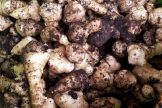
One of the hardiest of the Cannas. Attractive large lush bright green leaves and thick stalks forming clumps up to 2m high. A versatile plant – good as both an ornamental and a produce plant, producing high yields in good conditions, but able to survive and produce in poor dry soils as well as cope with light frosts. Takes full sun to part shade. The typical canna red flowers are not as showy as the ornamental cannas, but still attractive. The leaves can grow large enough and strong enough to use as picnic plates. Can grow in temperate, subtropical and tropical areas, but will be slower in the cooler regions.
Leaves have a higher protein content than the tubers and can be fed to farm stock.
Growing arrowroot
Easy! Plant all year round (except perhaps winter in cooler regions). Cover tubers with soil.
As the clumps grow and expand, they can be divided up.
Using arrowroot
Much better to use the tubers when they are small (tennis ball sized) as this way you avoid the fibres that form in older larger tubers.
They can be eaten raw, in stews/casseroles/soups/stir fries, steamed, roasted, chipped, diced and sliced! Commonly used to make flour, which has the added bonus of being gluten free. Great as a thickener which doesn’t make the sauce go cloudy, thus excellent for fruit sauces. Very useful for thickening acidic foods such as sweet and sour sauce. Also prevents ice crystals forming in ice-cream.
Arrowroot thickens at a lower temperature than does flour or cornstarch and tends to thin again at higher temperatures, so don’t over heat. Substitute two teaspoons of arrowroot for one tablespoon of cornstarch, or one teaspoon of arrowroot for one tablespoon of wheat flour.
Arrowroot flour
Peel tubers, slice/dice/mince or blend into a pulp, adding cold water as needed. Put into the largest bowl you have and fill with water, stir around and then leave for a few minutes. The pulp will sink to the bottom and a brown fibrous material will float to the top. Drain this off. Add more water, stir and repeat the process until no more fibre rises. Drain off the water and tip the pulp onto trays or pans, keep to 1cm thick. Dry in a warm sunny place. When the pulp is dry it produces soft and flaky white flour. Store in an airtight container and it will keep for months.





